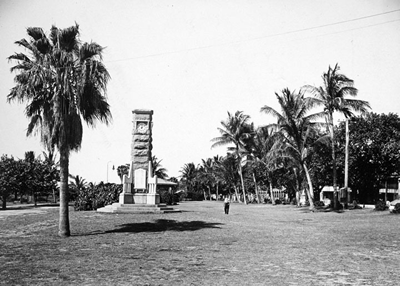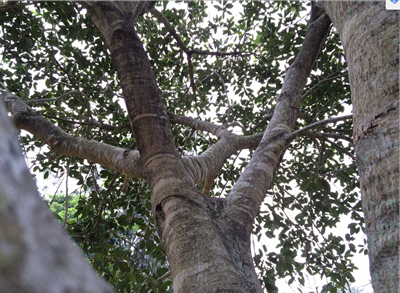English Stage 2
Overview

Anzac Cenotaph and Esplanade, Townsville, Queensland, c. 1935
©Public domain (Queensland State Archives, Digital Image ID 1345)
Through the text Memorial by Gary Crew and Shaun Tan, students explore the author’s and illustrator’s representations of memories, memorials and their significance in communities. Students compose a letter seeking to protect a community memorial and compose a poem that commemorates the fallen.
Teaching and learning activities

In 'Memorial', a fig tree is planted to remember those who served. Moreton Bay fig branches, 2015
Memorial by Gary Crew and Shaun Tan
By the statue of unknown soldier in the main street of a small country town is a huge Moreton Bay fig tree planted as a memorial after the First World War. As the town grows it eventually becomes a traffic hazard and needs to be removed. Although gone, the community’s memories of those who served in each war remain.
-
Read the story and discuss how the importance of memories is communicated through the story. Encourage students to share their memories of family, home and important events.
-
Explore how the story is told through the illustrations, for example, the ominous sequence where the reader realises the tree has been cut down.
-
Discuss the use of symbols in this book, such as seeds and birds. What does each of these convey?
-
Explore the ethical issues that were encountered in the destruction of a memorial to the fallen soldiers. Why did the author present this issue?
-
Explore the techniques used by the author to represent Australians in the text. How was a country town depicted in the story?
-
Compose a poem that addresses the commemoration of the fallen soldiers.
-
Compose a letter from the perspective of a member of the community addressing the need to preserve the memorial.
Other Texts
My Mother’s Eyes by Mark Wilson
A Day to Remember by Jackie French
Meet the Anzacs by Claire Saxby
Learning concepts
These additional questions can be used for discussion or further investigations.
Challenge
Discuss the challenge that the community faced in their determination to save the memorial to the fallen soldiers. How was this represented in the text?
Change
How are memories and changes represented in the text?
What changes have occurred since the First World War? What are the different ways that people have commemorated the soldiers?
How have people’s attitudes toward war changed over time? How do authors depict these changes?
Caring
Why does the young boy care so much about saving the tree? Why are memorials important to communities?
Community
How have people in the community used the memorial tree over time? How is this represented in the text?
Commemoration
What does a statue of an unknown soldier represent?
Why are trees and shrubs planted as memorials?
Syllabus links
EN2-10C thinks imaginatively, creatively and interpretively about information, ideas and texts when responding to and composing texts
Engage personally with texts
-
respond to texts by identifying and discussing aspects of texts that relate to their own experience
EN2-11D responds to and composes a range of texts that express viewpoints of the world similar to and different from their own
Understand and apply knowledge of language forms and features
-
make connections between students' own experiences and those of characters and events represented in texts
Develop and apply contextual knowledge
-
recognise the ways that stories depict Australians who are significant at a local and community level
Respond to and compose texts
-
describe and discuss ethical issues encountered in texts